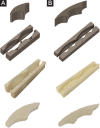Personalized anesthetic patches for dental applications
- PMID: 32596543
- PMCID: PMC7310263
- DOI: 10.18063/ijb.v5i2.1.203
Personalized anesthetic patches for dental applications
Abstract
Topical anesthetics are widely used in dental procedures. However, most commercially available medications are in the form of liquid or semisolid, which cannot provide prolonged effect intraorally. To address this issue, we proposed the use of three-dimensional printing (3DP) to fabricate a customizable dental anesthetic patch loaded with lidocaine that can be fitted perfectly onto the affected tooth. It has been shown that that patch can adhere on the tooth for more than 1 h, while releasing lidocaine from the patch made of hydrogels. In addition, the results illustrated the possibility of controlling the drug release profile by altering the shape of the patch, as well the use of a 3DP tooth model as the drug testing platform. Taken together, these data further reinforce the vast potential of the application of 3DP technology in personalized medicine.
Keywords: Adhesive; Dental patch; Drug release; Personalized medicine; Three-dimensional printing; Topical anesthetics.
Copyright: © 2019 Ou, et al.
Conflict of interest statement
The authors declare no conflicts of interest.
Figures





Similar articles
-
3D scanning and 3D printing as innovative technologies for fabricating personalized topical drug delivery systems.J Control Release. 2016 Jul 28;234:41-8. doi: 10.1016/j.jconrel.2016.05.034. Epub 2016 May 14. J Control Release. 2016. PMID: 27189134
-
Formulation and Characterization of a 3D-Printed Cryptotanshinone-Loaded Niosomal Hydrogel for Topical Therapy of Acne.AAPS PharmSciTech. 2020 May 31;21(5):159. doi: 10.1208/s12249-020-01677-1. AAPS PharmSciTech. 2020. PMID: 32476076
-
Mucoadhesive Electrospun Patch Delivery of Lidocaine to the Oral Mucosa and Investigation of Spatial Distribution in a Tissue Using MALDI-Mass Spectrometry Imaging.Mol Pharm. 2019 Sep 3;16(9):3948-3956. doi: 10.1021/acs.molpharmaceut.9b00535. Epub 2019 Aug 15. Mol Pharm. 2019. PMID: 31361498 Free PMC article.
-
Role of Polymers in 3D Printing Technology for Drug Delivery - An Overview.Curr Pharm Des. 2018;24(42):4979-4990. doi: 10.2174/1381612825666181226160040. Curr Pharm Des. 2018. PMID: 30585543 Review.
-
An Overview of 3D Printing Technologies for Soft Materials and Potential Opportunities for Lipid-based Drug Delivery Systems.Pharm Res. 2018 Nov 7;36(1):4. doi: 10.1007/s11095-018-2531-1. Pharm Res. 2018. PMID: 30406349 Review.
Cited by
-
Novel Soft Dosage Forms for Paediatric Applications: Can We 3D-Print Them or Not?Gels. 2025 Mar 8;11(3):187. doi: 10.3390/gels11030187. Gels. 2025. PMID: 40136892 Free PMC article. Review.
-
Development of a 3D-printed Medication Label for the Blind and Visually Impaired.Int J Bioprint. 2020 Apr 30;6(2):276. doi: 10.18063/ijb.v6i2.276. eCollection 2020. Int J Bioprint. 2020. PMID: 32782996 Free PMC article.
-
Physiology of pregnancy and oral local anesthesia considerations.PeerJ. 2023 Jun 29;11:e15585. doi: 10.7717/peerj.15585. eCollection 2023. PeerJ. 2023. PMID: 37404472 Free PMC article. Review.
-
Bioprinting and biofabrication for tissue engineering in Asia.Int J Bioprint. 2019 Sep 18;5(2.1):231. doi: 10.18063/ijb.v5i2.1.231. eCollection 2019. Int J Bioprint. 2019. PMID: 32923735 Free PMC article. No abstract available.
References
-
- Armfield JM, Milgrom P. 2011, A Clinician Guide to Patients Afraid of Dental Injections and Numbness. SAAD Dig. 27:33–9. - PubMed
-
- Oni G, Brown S, Kenkel J. 2012, Comparison of Five Commonly-available, Lidocaine-containing Topical Anesthetics and their Effect on Serum Levels of Lidocaine and Its Metabolite Monoethylglycinexylidide (MEGX) Aesthet Surg J. 32(4):495–503. DOI 10.1177/1090820X12442672. - PubMed
-
- Ueda HMC, Shah VP, Derdzinski K, et al. 2009, Topical and Transdermal Drug Products. U S Pharmacopeial Natl Formul. 35(3):750–64.
LinkOut - more resources
Full Text Sources
